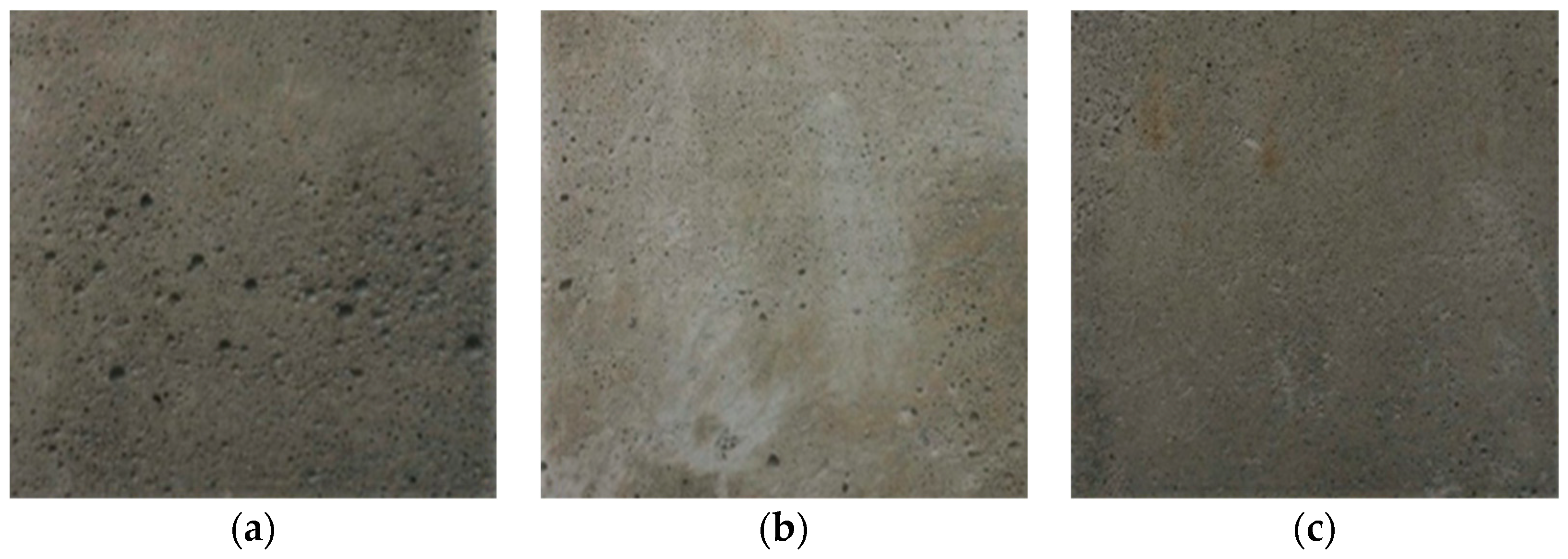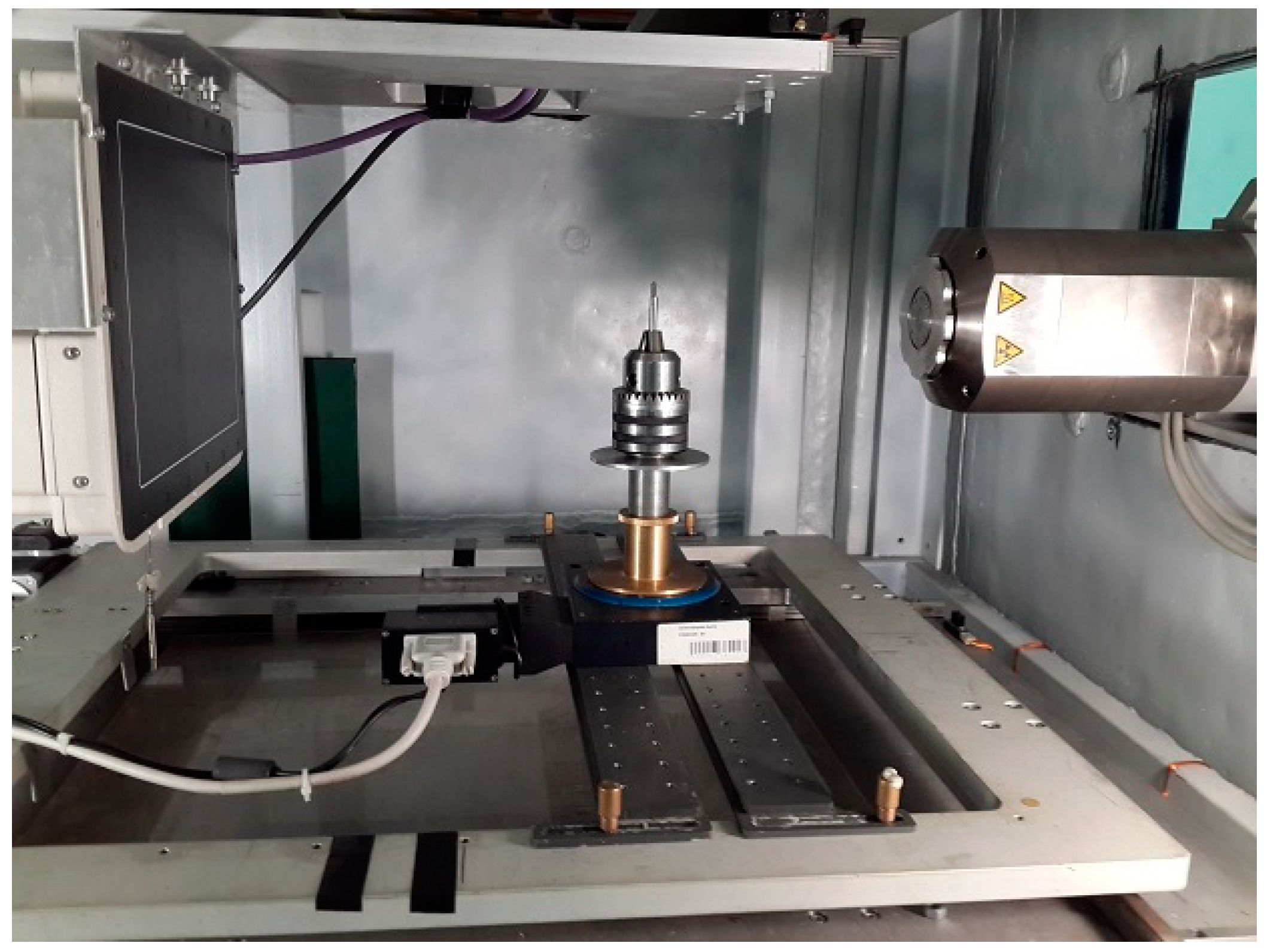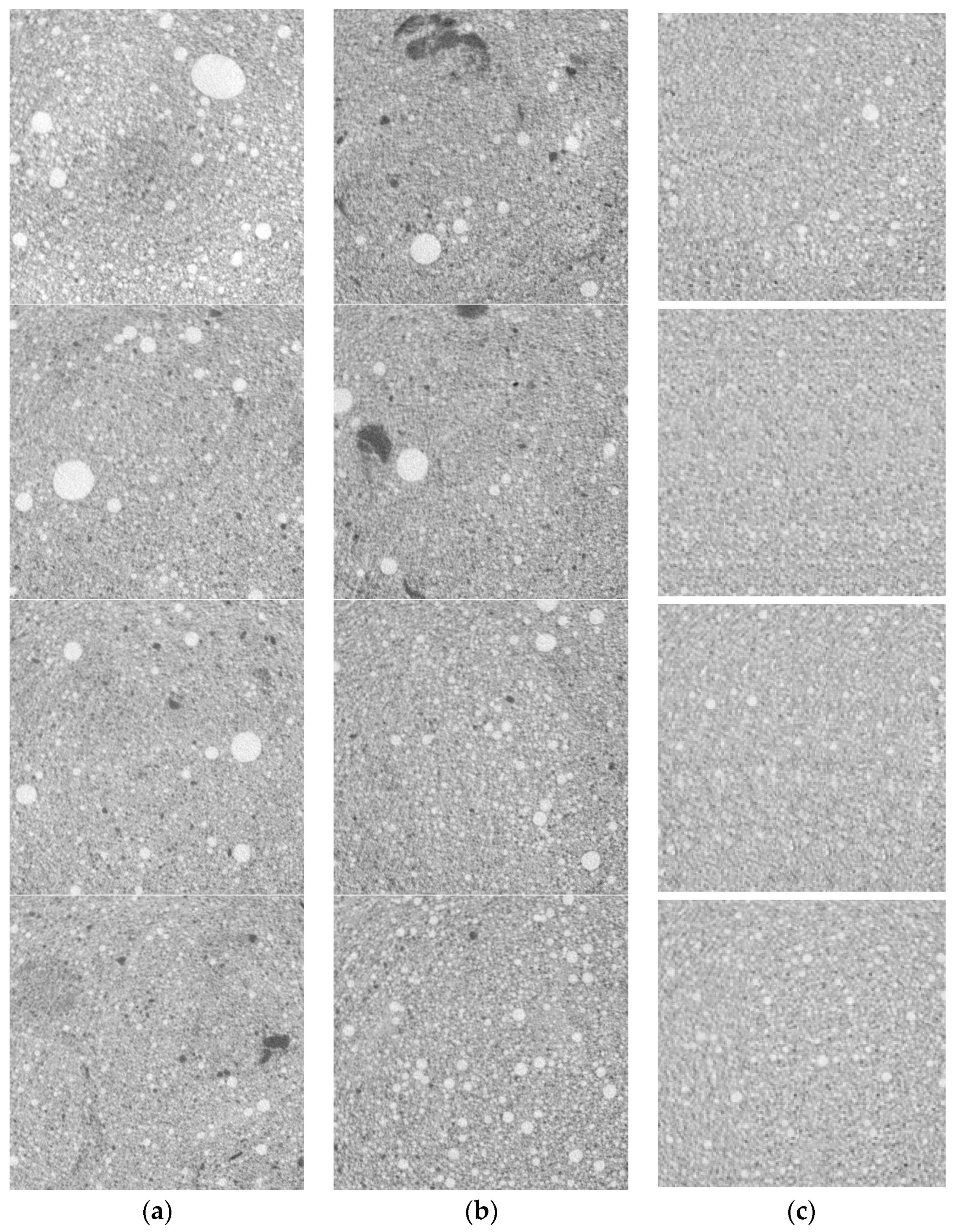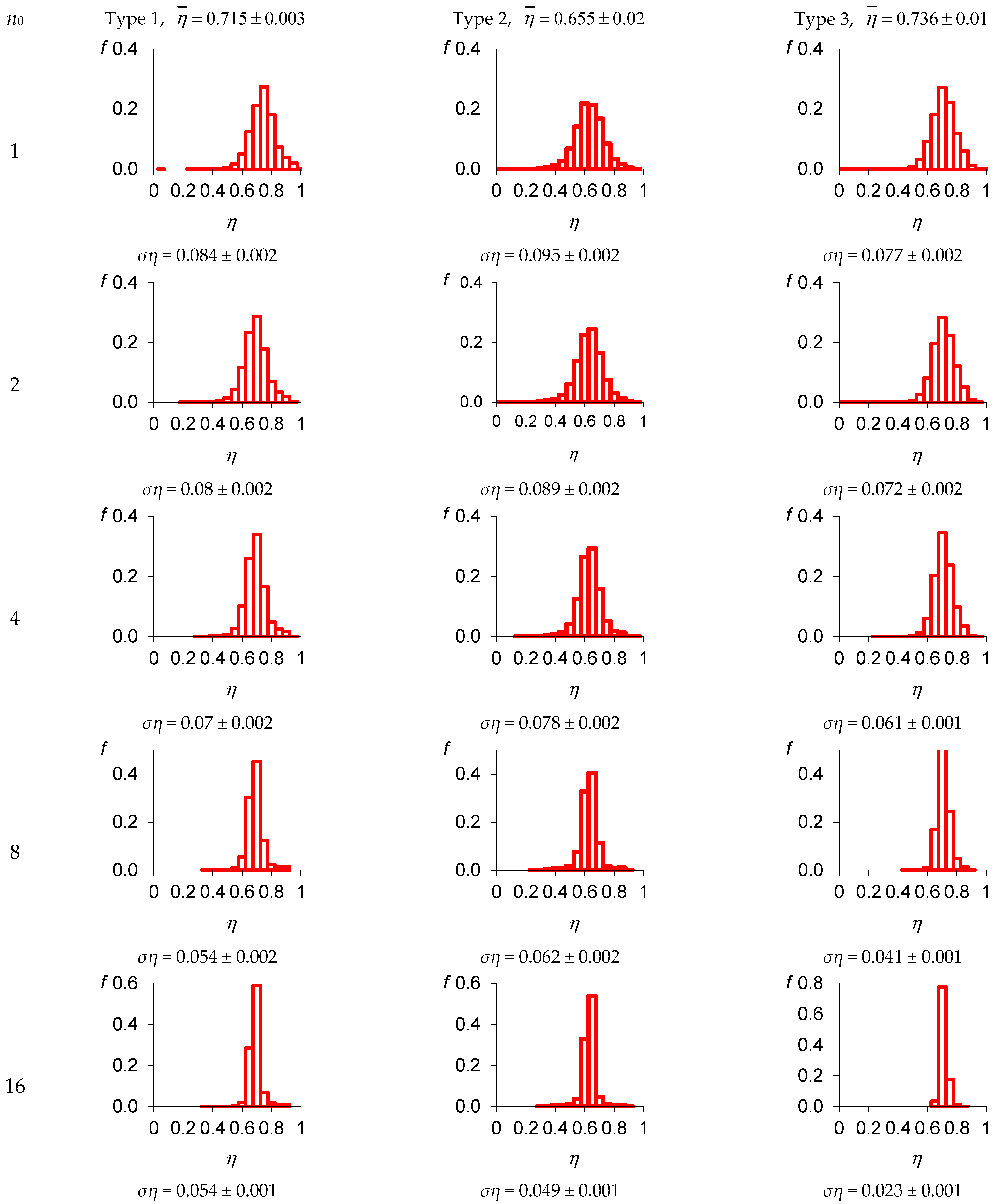Algorithm of Estimation of the Degree of Porosity Homogeneity of Foamed Concretes by Local Volumes by X-ray Computed Tomography Method
Abstract
1. Introduction
- -
- substantiate the need to assess the degree of homogeneity of foam concrete samples in terms of porosity by local volumes;
- -
- develop an algorithm for assessing the degree of homogeneity of foam concrete samples in terms of porosity parameters by local volumes using the CT method;
- -
- base the experimental tests of several samples of foam concrete using X-ray computed tomography to demonstrate the possibility of using the developed algorithm;
- -
- illustrate the applicability of the developed algorithm for comparing the efficiency of foam concrete production technologies.
2. Materials and Methods
2.1. Materials
2.2. Methods
2.2.1. Used Hardware
2.2.2. XCT Projection Formation and Reconstruction
2.2.3. Pore Distribution Homogeneity
3. Results
3.1. XCT Visualization of Internal Structure of Foam Concrete Specimens
3.2. Calculation of Pore Distribution Homogeneity
4. Discussion
5. Conclusions
- Algorithm and program in MathCad for assessing the degree of homogeneity of foam concrete in terms of porosity parameters by local volumes using the X-ray computed tomography method;
- Demonstration of the possibility of using the developed algorithm based on experimental tests of several samples of foam concrete using X-ray computed tomography;
- Illustration of the applicability of the developed algorithm for comparing the efficiency of technologies for the production of foam concrete on the example of samples of standard foam concrete and foam concretes modified with fly ash and thermally modified peat;
- Evidence of the high quality of foam concrete modified with thermally modified peat according to the criterion of a high degree of uniformity in terms of porosity parameters by local volumes, based on high levels of porosity in local volumes, as well as lower values of standard deviations of porosity by local volumes and narrowing of the porosity distribution density as sizes increase local volumes.
Author Contributions
Funding
Institutional Review Board Statement
Informed Consent Statement
Data Availability Statement
Conflicts of Interest
References
- Xian, G.; Liu, Z.; Wang, Z.; Zhou, X. Study on the Performance and Mechanisms of High-Performance Foamed Concrete. Materials 2022, 15, 7894. [Google Scholar] [CrossRef]
- Tang, W.; Chen, P.; Lin, Z.; Zhang, L.; Zheng, W.; Huang, X.; Zhang, Y.; Zhang, W. Effectively reutilizing waste clay brick to prepare a novel green foam concrete base on a new two-step paste substitution method. Constr. Build. Mater. 2023, 372, 130794. [Google Scholar] [CrossRef]
- Fu, Y.; Wang, X.; Wang, L.; Li, Y. Foam concrete: A state-of-the-art and state-of-the-practice review. Adv. Mater. Sci. Eng. 2020, 2020, 6153602. [Google Scholar] [CrossRef]
- Raj, A.; Sathyan, D.; Mini, K.M. Physical and functional characteristics of foam concrete: A review. Constr. Build. Mater. 2019, 221, 787–799. [Google Scholar] [CrossRef]
- Zhou, Y.; Tian, Y.; Peng, X. Applications and Challenges of Supercritical Foaming Technology. Polymers 2023, 15, 402. [Google Scholar] [CrossRef]
- Li, J.; Chen, Z.; Chen, W.; Xu, Z. Seismic performance of pre-cast self-insulation shear walls made by a new type of foam concrete with high strength and low thermal conductivity. Structures 2020, 24, 124–136. [Google Scholar] [CrossRef]
- Fediuk, R.; Amran, M.; Vatin, N.; Vasilev, Y.; Lesovik, V.; Ozbakkaloglu, T. Acoustic Properties of Innovative Concretes: A Review. Materials 2021, 14, 398. [Google Scholar] [CrossRef]
- Lukpanov, R.E.; Dyussembinov, D.S.; Utepov, Y.B.; Bazarbayev, D.O.; Tsygulyov, D.V.; Yenkebayev, S.B.; Shakhmov, Z.A. Homogeneous pore distribution in foam concrete by two-stage foaming. Mag. Civ. Eng. 2021, 103, 10313. [Google Scholar] [CrossRef]
- Ji, Z.; Li, M.; Su, L.; Pei, Y. Porosity, mechanical strength and structure of waste-based geopolymer foams by different stabilizing agents. Constr. Build. Mater. 2020, 258, 119555. [Google Scholar] [CrossRef]
- Kim, K.W.; Lim, H.M.; Yoon, S.-Y.; Ko, H. Fast-Curing Geopolymer Foams with an Enhanced Pore Homogeneity Derived by Hydrogen Peroxide and Sodium Dodecyl Sulfate Surfactant. Minerals 2022, 12, 821. [Google Scholar] [CrossRef]
- El Masri, Y.; Rakha, T. A scoping review of non-destructive testing (NDT) techniques in building performance diagnostic inspections. Constr. Build. Mater. 2020, 265, 120542. [Google Scholar] [CrossRef]
- Wang, B.; Zhong, S.; Lee, T.L.; Fancey, K.S.; Mi, J. Non-destructive testing and evaluation of composite materials/structures: A state-of-the-art review. Adv. Mech. Eng. 2020, 12. [Google Scholar] [CrossRef]
- Sidiq, A.; Gravina, R.J.; Setunge, S.; Giustozzi, F. High-efficiency techniques and micro-structural parameters to evaluate concrete self-healing using X-ray tomography and mercury intrusion porosimetry: A review. Constr. Build. Mater. 2020, 252, 119030. [Google Scholar] [CrossRef]
- Li, N.; Zhao, Y.; Xing, Y.; He, X. Localized Damage Analysis of Cement Mortar Using X-ray Computed Tomography In Situ Compressive Loading and Digital Volume Correlation. Appl. Sci. 2023, 13, 3842. [Google Scholar] [CrossRef]
- Koenig, A. Analysis of air voids in cementitious materials using micro X-ray computed tomography (µXCT). Constr. Build. Mater. 2020, 244, 118313. [Google Scholar] [CrossRef]
- Eller, B.; Movahedi Rad, M.; Fekete, I.; Szalai, S.; Harrach, D.; Baranyai, G.; Kurhan, D.; Sysyn, M.; Fischer, S. Examination of Concrete Canvas under Quasi-Realistic Loading by Computed Tomography. Infrastructures 2023, 8, 23. [Google Scholar] [CrossRef]
- Liu, S.; Huang, Z. Analysis of strength property and pore characteristics of Taihang limestone using X-ray computed tomography at high temperatures. Sci. Rep. 2021, 11, 13478. [Google Scholar] [CrossRef]
- Zhang, Z.; Rao, F.; Ye, G.; Liu, J. Mechanical Performance and Void Structure Change of Foamed Cement Paste Subjected to Static and Cyclic Loading under Plane Strain Conditions. Materials 2022, 15, 1711. [Google Scholar] [CrossRef]
- Osipov, S.P.; Prischepa, I.A.; Chakhlov, S.V.; Osipov, O.S.; Usachev, E.Y. Algorithms for modeling the formation and processing of information in X-ray tomography of foam materials. Russ. J. Nondestruct. Test. 2021, 57, 238–250. [Google Scholar] [CrossRef]
- Prishchepa, I.A.; Kudyakov, A.I.; Sarkisov, Y.S.; Gorlrenko, N.P.; Zhuravlev, V.S.; Suslyaev, V.I.; Ugodenko, D.O. Formation of the structure of foam concrete with a thermally modified peat additive in the early stages of hardening. Bull. Tomsk. State Univ. Chem. 2020, 18, 35–46. [Google Scholar] [CrossRef]
- Osipov, S.P.; Prishchepa, I.A.; Kudyakov, A.I.; Batranin, A.V.; Osipov, O.S. Computer tomography of foam concrete systems. Methods Technol. 2018, 2, 146–152. [Google Scholar] [CrossRef]
- Prischepa, I.A.; Osipov, S.P.; Osipov, O.S.; Prischepa, A.B. Certificate of State Regis-tration of a Computer Program No. 2018617893, dated 3 July 2018 (In Russian). “Assess-ment of the Degree of Homogeneity of Foam Concrete by Local Volumes (LV) by Computed Tomography”. Available online: https://fips.ru/iiss/document.xhtml?faces-redirect=true&id=48e9fd34a6521bc403c15e48cdbcde9d (accessed on 28 February 2023).
- Steshenko, A.B.; Kudyakov, A.I. Cement based foam concrete with aluminosilicate microspheres for monolithic construction. Mag. Civ. Eng. 2018, 84, 86–96. [Google Scholar] [CrossRef]
- Kryzhanivskyi, Y.; Koshlak, H. Obtaining porous thermal insulating materials based on ash from thermal power plants. Int. J. Environ. Sci. Technol. 2020, 4, 3–12. [Google Scholar]
- Ta, X.; Zhang, Y.; Wan, Z.; Shi, P.; Zhou, J. Study on Preparation and Performance of CO2 Foamed Concrete for Heat Insulation and Carbon Storage. Materials 2023, 16, 2725. [Google Scholar] [CrossRef]
- Kudyakov, A.I.; Sarkisov, J.S.; Kopanitsa, N.O.; Kasatkina, A.V.; Prischepa, I.A. Foam concrete of increased strength with the thermomodified peat additives. IOP Conf. Ser. Mater. Sci. Eng. 2015, 71, 012012. [Google Scholar] [CrossRef]
- Kapustin, F.; Belyakov, V.A. Application of modified peat aggregate for lightweight concrete. Solid State Phenom. 2020, 309, 120–125. [Google Scholar] [CrossRef]
- X-ray Micro-Tomograph “OREL-MT”. Available online: https://portal.tpu.ru/departments/laboratory/rknl/eng/products/orel_tomo (accessed on 28 February 2023).
- Osipov, S.P.; Yadrenkin, I.G.; Chakhlov, S.V.; Osipov, O.S.; Usachev, E.Y.; Manushkin, A.A. Calculation model of X-ray computed tomography with density assessment function. Russ. J. Nondestruct. Test. 2021, 57, 222–237. [Google Scholar] [CrossRef]
- Hsieh, J. Computed Tomography: Principles, Design, Artifacts, and Recent Advances; SPIE: Bellingham, WA, USA, 2015. [Google Scholar]
- Ketcham, R.A.; Carlson, W.D. Acquisition, optimization and interpretation of X-ray computed tomographic imagery: Applications to the geosciences. Comput. Geosci. 2001, 27, 381–400. [Google Scholar] [CrossRef]
- Alvarez, R.E.; Macovski, A. Energy-selective reconstructions in X-ray computerised tomography. Phys. Med. Biol. 1976, 21, 733–744. [Google Scholar] [CrossRef]
- Chung, S.Y.; Lehman, C.; Abd Elrahman, M.; Stephan, D. Pore characteristics and their effects on the material properties of foamed concrete evaluated using micro-CT images and numerical approaches. Appl. Sci. 2017, 7, 550. [Google Scholar] [CrossRef]
- Batool, F.; Khan, M.S.; Bindiganavile, V. Characterization of 3D microstructure, thermal conductivity, and heat flow of cement-based foam using imaging technique. Front. Struct. Civ. Eng. 2021, 15, 643–651. [Google Scholar] [CrossRef]
- Yuanliang, X.; Baoliang, L.; Chun, C.; Yamei, Z. Properties of foamed concrete with Ca(OH)2 as foam stabilizer. Cem. Concr. Compos. 2021, 118, 103985. [Google Scholar] [CrossRef]







| Spatial resolution | >5 µm |
| Slice thickness | Variable from 0.5 to 150 mm |
| Weight capacity | ≤20 kg |
| Pallet dimensions | 1150 × 600 × 550 mm |
| X-ray unit model | XWT 160–TC (X-ray WorX) |
| Anode voltage | 10 to 160 kV |
| Anode current | 0.05–1.0 µA |
| Focal spot | 1.4 µm |
| Planar detector model | PaxScan 2520 V (Varian) |
| Pixel size | 127 µm |
| Detector size | 193 mm × 242 mm |
Disclaimer/Publisher’s Note: The statements, opinions and data contained in all publications are solely those of the individual author(s) and contributor(s) and not of MDPI and/or the editor(s). MDPI and/or the editor(s) disclaim responsibility for any injury to people or property resulting from any ideas, methods, instructions or products referred to in the content. |
© 2023 by the authors. Licensee MDPI, Basel, Switzerland. This article is an open access article distributed under the terms and conditions of the Creative Commons Attribution (CC BY) license (https://creativecommons.org/licenses/by/4.0/).
Share and Cite
Osipov, S.; Prischepa, I. Algorithm of Estimation of the Degree of Porosity Homogeneity of Foamed Concretes by Local Volumes by X-ray Computed Tomography Method. Materials 2023, 16, 3244. https://doi.org/10.3390/ma16083244
Osipov S, Prischepa I. Algorithm of Estimation of the Degree of Porosity Homogeneity of Foamed Concretes by Local Volumes by X-ray Computed Tomography Method. Materials. 2023; 16(8):3244. https://doi.org/10.3390/ma16083244
Chicago/Turabian StyleOsipov, Sergey, and Inga Prischepa. 2023. "Algorithm of Estimation of the Degree of Porosity Homogeneity of Foamed Concretes by Local Volumes by X-ray Computed Tomography Method" Materials 16, no. 8: 3244. https://doi.org/10.3390/ma16083244
APA StyleOsipov, S., & Prischepa, I. (2023). Algorithm of Estimation of the Degree of Porosity Homogeneity of Foamed Concretes by Local Volumes by X-ray Computed Tomography Method. Materials, 16(8), 3244. https://doi.org/10.3390/ma16083244







